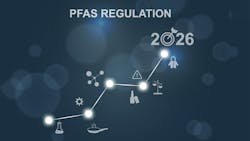EPA Outlines New Actions to Regulate PFAS Contamination
U.S. Environmental Protection Agency Administrator Lee Zeldin announced a series of regulatory and enforcement actions April 28 to address per- and polyfluoroalkyl substances (PFAS) contamination. The initiatives focus on improving testing methods, setting industrial discharge limits, enforcing pollution controls and establishing a framework to assign liability for contamination.
Key actions include designating a PFAS agency lead to coordinate efforts across EPA offices and developing updated effluent limitations guidelines for PFAS manufacturers and metal finishing operations. These steps aim to reduce the entry of PFAS into drinking water systems, according to the EPA.
EPA plans to strengthen scientific research through a testing strategy under the Toxic Substances Control Act (TSCA) Section 4 and to launch additional efforts to gather data on PFAS air emissions, according to the statement. The agency also intends to update PFAS destruction and disposal guidance annually rather than every three years as treatment technologies evolve.
To fulfill statutory obligations, the EPA said it will:
- Add PFAS to the Toxic Release Inventory in line with the 2020 National Defense Authorization Act
- Use authorities under TSCA, the Clean Water Act and the Safe Drinking Water Act to investigate and prevent PFAS releases
- Develop national primary drinking water regulations for certain PFAS
- Prioritize risk-based reviews for new and existing PFAS chemicals
- Implement Section 8(a)(7) of TSCA to collect information without overburdening small businesses and article importers
EPA also is working with Congress and industry to establish a liability framework that places financial responsibility on polluters while protecting passive receivers such as public drinking water utilities, according to Zeldin.
Partnership efforts will include assisting states and tribes with enforcement, assessing biosolids risks, advancing PFAS remediation where drinking water is impacted and supporting investigations into violations, the agency said.
The actions represent an initial phase of a broader, ongoing effort across all EPA program offices to support communities affected by PFAS contamination, Zeldin said.
About the Author
Amanda Joshi
Managing Editor
Amanda Joshi has more than 18 years of experience in business-to-business publishing for both print and digital content. Before joining Chemical Processing, she worked with Manufacturing.net and Electrical Contracting Products. She’s a versatile, award-winning editor with experience in writing and editing technical content, executing marketing strategy, developing new products, attending industry events and developing customer relationships.
Amanda graduated from Northern Illinois University in 2001 with a B.A. in English and has been an English teacher. She lives in the Chicago suburbs with her husband and daughter, and their mini Aussiedoodle, Riley. In her rare spare time, she enjoys reading, tackling DIY projects, and horseback riding.

